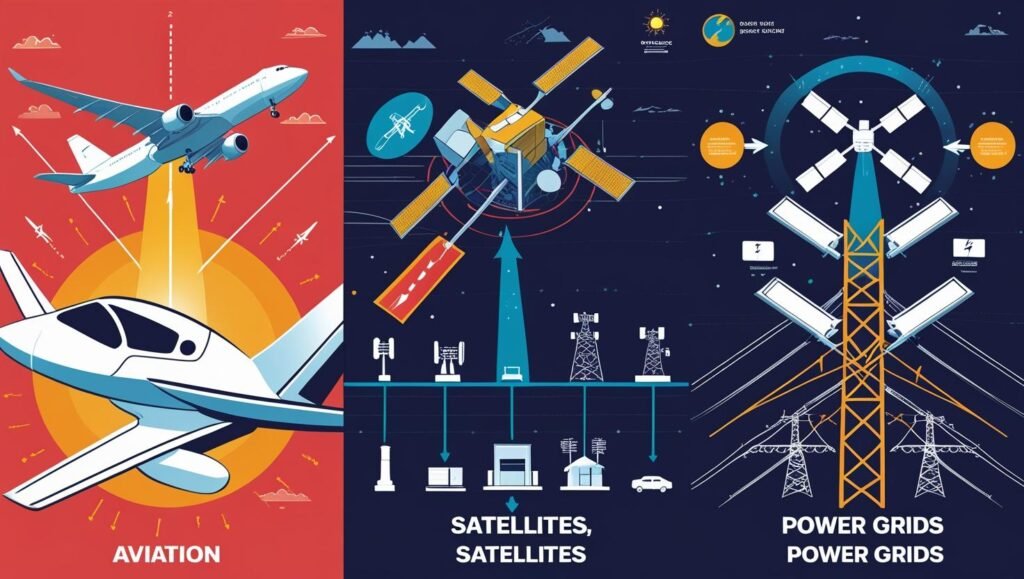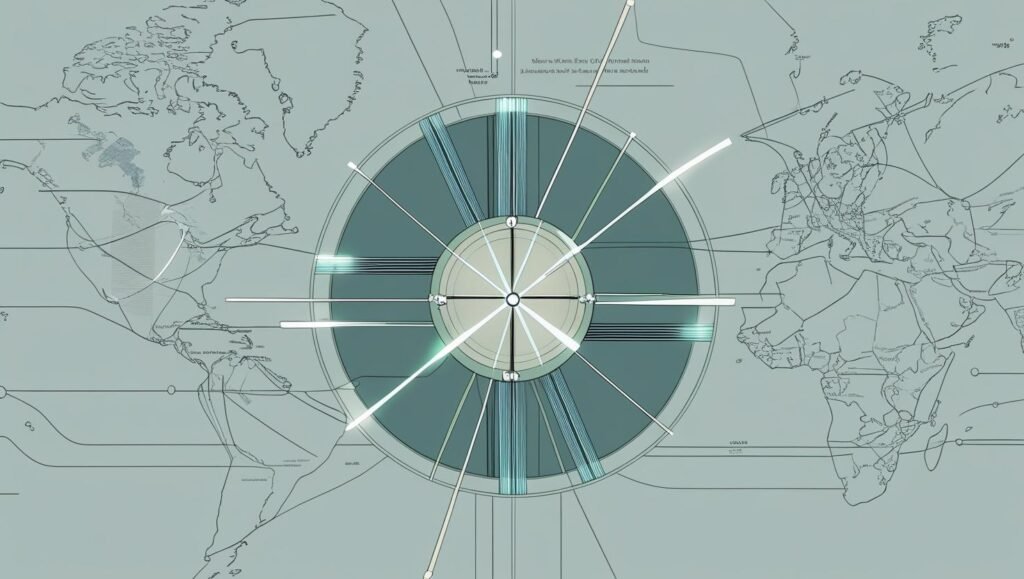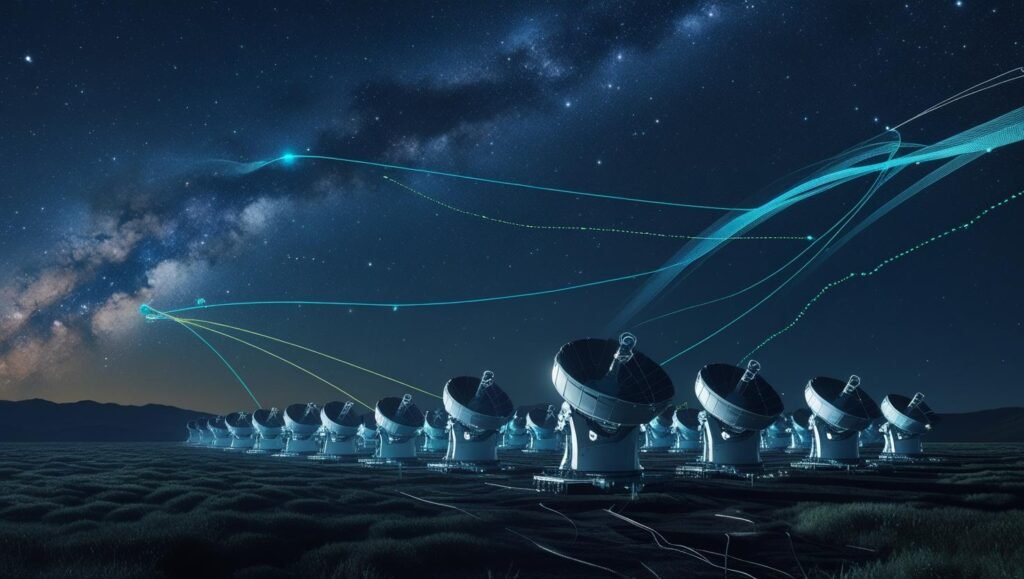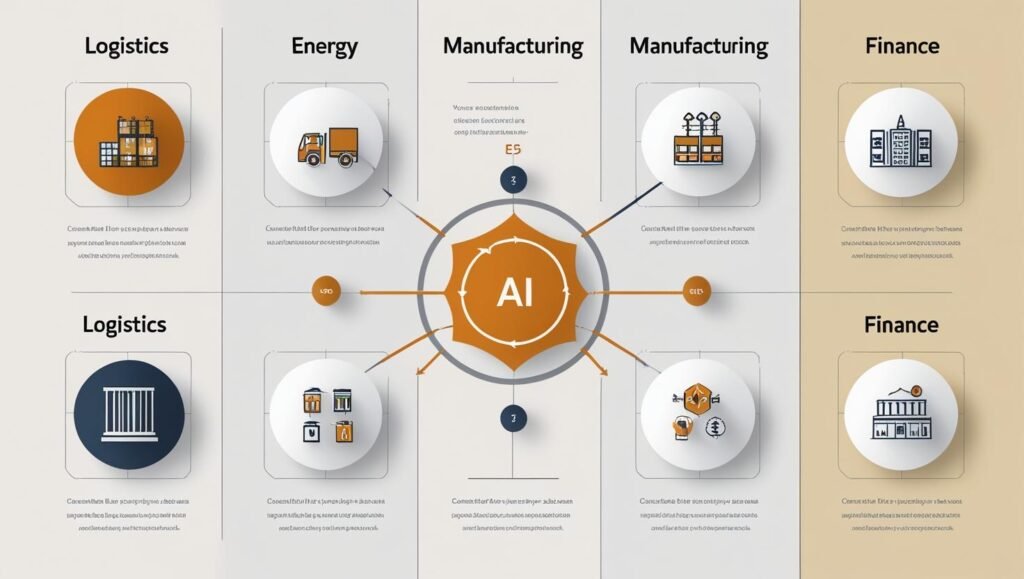Space Weather AI — How Solar Storms & Quantum Clocks Will Rewire Industry
Space is not silent—cosmic rays, solar storms, and deep-time astrophysics influence everything from satellites to supply chains. Pair that with breakthroughs in AI (foundation models, self-optimizing agents, quantum-aided sensing), and we’re staring at a hinge moment for civilization. This essay connects hard science with near-term industry impact, sorts myths vs. facts, and maps what bold companies can build next.
This essay examines "space weather AI" — how solar storms, quantum clocks and live sensing will reshape AI systems and industry risk models.
When the Sky Writes in Particles
Satellites glitch, high-latitude flights reroute, transformers hum a worried note—and down on Earth we call it “a bad day.” Up above, the Sun sneezes. A coronal mass ejection barrels out. Cosmic rays—ancient messengers born in supernovae—thread our atmosphere like ghostly needles. Space weather is no metaphor; it is a market variable.
Meanwhile, AI has moved from clever autocomplete to agentic systems that plan, act, and learn across toolchains. We don’t have AGI (a truly general mind), but we do have AI that behaves like a team of interns on espresso—fast, capable, sometimes wrong, often useful. The next leap will be less about bigger models and more about wiring the world into the model: sensors, satellites, quantum clocks, real-time energy prices, fleet telemetry, and live risk feeds.
In short: the cosmos stirs the soup, AI tastes it, industry serves it hot.
Global idioms for the vibe:
English: When it rains, it pours.
Hindi: आंधी में चिराग़ जलाना (lighting a lamp in a storm—bold persistence).
Spanish: A río revuelto, ganancia de pescadores (turbulent waters favor the fisher who’s ready).
Japanese: 石橋を叩いて渡る (tap the stone bridge before crossing—prudence).

Why space weather AI matters — real business risks and engineering needs
Space Weather 101: Cosmic Rays, Solar Flares, and “Quiet” Chaos
What are cosmic rays?
High-energy particles (mostly protons) from supernovae, active galactic nuclei, and the Sun. When they slam into our atmosphere, they trigger showers of secondary particles. At scale, this influences avionics, satellite electronics, and even atmospheric chemistry.
Why solar flares and CMEs matter:
HF radio & GNSS: Flares can black out high-frequency communications and degrade GPS accuracy, hitting aviation and logistics.
Power grids: CMEs induce geomagnetically induced currents (GICs) that stress transformers.
Satellites: Increased atmospheric drag during solar storms can deorbit low-mass sats faster than planned.
Quiet does not mean harmless.
Even in “quiet” cycles, prolonged exposure changes baseline risk. Think tail risk: rare, severe, and compound (storm + grid vulnerability + market panic). For operators, resilience beats prediction: design for failure, rehearse graceful degradation, diversify comms.
Business lens: If your supply chain crosses oceans or poles, build a space-weather playbook: alternative routes, comms redundancy, on-orbit data diversity, and insurance clauses that recognize geomagnetic events.

Quantum Time: Clocks, Sensors, and the Death of Drift
Atomic clocks have long anchored GPS and finance. Next-gen quantum clocks (optical lattice clocks, ion clocks) promise stability that makes drift negligible over useful horizons. Add quantum magnetometers and cold-atom interferometers for navigation without GPS: ships, drones, subsea, and underground equipment can hold course using local physics.
A core promise of space weather AI is time-anchored trust: quantum clocks + live geomagnetic data reduce misalignment between distributed agents and the physical world.
Why it matters for AI:
Tighter timestamps → cleaner sensor fusion → fewer model hallucinations in time-critical tasks.
Dead-reckoning on steroids → resilient autonomy when signals jam or spoof.
Edge inference + precise time → robust distributed control (power grids, factories, fleets).
Idioms:
English: Measure twice, cut once.
French: Le diable est dans les détails.
Arabic: الصبر مفتاح الفرج (patience is the key to relief).
The quantum edge is mostly about details and patience—calibration as competitive advantage.

AGI, Agentic AI & the Systems Problem
We don’t need full AGI to transform industries. We need agentic AI that coordinates tools, reasons over uncertainty, and knows when to ask a human. Three pillars:
World-model grounding: fuse live data (weather, prices, telemetry) into the model’s context.
Tool orchestration: planners that call APIs, run simulations, file tickets, and check results.
Alignment & guardrails: policy constraints, red-teaming, human override, audit trails.
The real choke point isn’t parameters; it’s systems engineering—latency budgets, consistency under failure, and data contracts that stop silent schema drift.
Playbook snippet:
Start with a narrow agent (e.g., “reroute flights when Kp index > threshold, preserving SLAs”).
Add real-time feeds: space weather indices, port congestion, jet fuel prices.
Train on your own history: actions → outcomes.
Bake in “ask a human” thresholds and model-critique loops.
Proverb (Chinese): 工欲善其事,必先利其器.
To do a good job, first sharpen your tools. In AI, your tools are data pipelines, evaluators, and rollback switches.
Signals in the Noise: SETI, Technosignatures & Healthy Skepticism
Are we alone? The smart answer: We don’t know yet. Surveys probe biosignatures (like atmospheric methane + oxygen out of equilibrium) and technosignatures (narrowband radio, waste heat, industrial gases).
JWST has observed exoplanet atmospheres (e.g., CO₂ in WASP-39b), proving we can do chemistry at distance.
Radio SETI continues scanning; optical SETI looks for laser pulses; infrared searches explore waste heat.
Healthy skepticism is non-negotiable: extraordinary claims, extraordinary evidence.
My stance: Treat the search as a moonshot with spillover benefits—better sensors, better data methods, better planetary stewardship.

The Energy Math: Why Joules Decide Futures
AI eats energy. Space systems eat energy. Electrification eats energy. The world will negotiate the energy trilemma—security, affordability, sustainability.
Short list of realities:
Computing demand keeps climbing; efficiency gains fight a rising tide.
Grid flexibility (storage, responsive load) becomes king.
Arctic/remote resource plays (hydrocarbons, critical minerals) collide with climate risk and geopolitics.
Shipping lanes & satellite broadband reshape trade patterns; energy logistics re-route around climate and conflict.
What wins?
Data-center siting near stranded renewables, hydro, nuclear (including SMR pilots where regulation allows), and waste heat reuse into district heating.
AI for energy orchestration—model-predictive control that arbitrages price, carbon, and reliability.
Sensors + agents across grids, pipelines, ships: observe → infer → act.
Hindi phrase: दूध का जला छाछ भी फूँक-फूँक कर पीता है — burned once, sip carefully. After recent energy shocks, resilience beats maximal efficiency.
Myths vs. Facts (Fast, Straight, No Chaser)
Myth: “Cosmic rays cause most electronics failures.”
Fact: They can cause bit flips at altitude/space; on Earth, modern ECC and design practices mitigate most risks. Design for the tail.
Myth: “Quantum computers will crack everything tomorrow.”
Fact: Progress is real but noisy; post-quantum crypto planning matters now, but classical + hybrid AI will dominate near-term.
Myth: “AGI is here.”
Fact: We have powerful pattern learners + tool-using agents. Generality across domains with robust causal reasoning remains open.
Myth: “SETI has found signals but they’re hidden.”
Fact: No confirmed technosignature to date. Data is public across many programs; claims require reproducible evidence.
Myth: “Solar storms are apocalypse events.”
Fact: Serious but manageable with grid hardening, operational playbooks, and redundancy.
space weather AI — quick checklist for product teams
• Ingest Kp/AE indices and solar alerts into your data fabric. NOAA Space Weather Prediction Center
• Add GNSS-denied navigation fallback (quantum/INS hybrid).
• Add geomagnetic event triggers to incident runbooks and SLA logic.
• Red-team agentic workflows with space-weather failure scenarios.
What This Means for Business (Playbooks You Can Use)
A) Aviation, Maritime & Logistics
Space-weather aware routing: integrate Kp index, radiation maps, auroral ovals.
GNSS-denied operations: pilot quantum/INS hybrid nav on critical lanes.
Agentic replanning: fuse port congestion + fuel prices + storm risk; simulate alternatives, push decisions with confidence bands.
B) Energy & Utilities
Predictive balancing: LLM + control stack to schedule storage, flexible loads, and CHP units.
Transformer risk: tie geomagnetic alerts to automated load shedding scenarios (human-in-the-loop).
Telemetry QA: contractually lock data schemas; automatic drift alarms.
C) Manufacturing & Mining
Digital twins with real-time sensor fusion.
Autonomy underground/indoors: quantum-aided dead-reckoning + computer vision; edge inference for safety.
D) Finance & Insurance
Parametric covers for geomagnetic storms, satellite outages.
Portfolio stress tests on energy shocks and shipping reroutes.
ESG realism: measure actual carbon with sensor-verified ledgers, not just promises.

Risk, Ethics, and the Human Factor
Safety: Red-team agents, simulate bad weather (literal and figurative), and budget for the rollback path.
Security: Assume model + data + toolchain are attack surfaces. Use signed artifacts, access policies, and non-overlapping blast radii.
Fairness: When agents allocate energy or reroute flights, who bears the cost? Embed governance and audit trails.
Culture: Train teams in “trust, but verify.” Incentivize “pause and escalate.”
Story: Humans run the last mile. A good tool makes the craftsman better; a bad process makes the craftsman bitter.
Field Notes, Sources & Further Reading
Space & Astrophysics
NASA Heliophysics missions (Parker Solar Probe; Solar Dynamics Observatory)
NOAA Space Weather Prediction Center (space weather alerts, Kp index)
ESA space environment guidelines (radiation & satellite ops)
IceCube Collaboration (astrophysical neutrinos)
Event Horizon Telescope Collaboration (black hole imaging)
Exoplanets & Biosignatures
JWST transit spectroscopy (e.g., WASP-39b CO₂ detection)
Nature / Science coverage on exoplanet atmospheres & retrieval methods
SETI Institute white papers on technosignatures
AI & Systems
MIT CSAIL & industry research on foundation models and tool use
NIST AI Risk Management Framework
IEEE standards on AI transparency & safety
Quantum & Sensing
Review articles on optical lattice clocks and atom interferometry
National metrology labs’ public briefs on timekeeping advances
(Note: These are stable, authoritative domains for ongoing updates.)
Further Reading
Revolutionizing Healthcare and Robotics with Wearable Ultrasound … (AI + robotics in healthcare)
About A SQUARE SOLUTIONS
- August 19, 2025
- asquaresolution
- 4:02 pm
